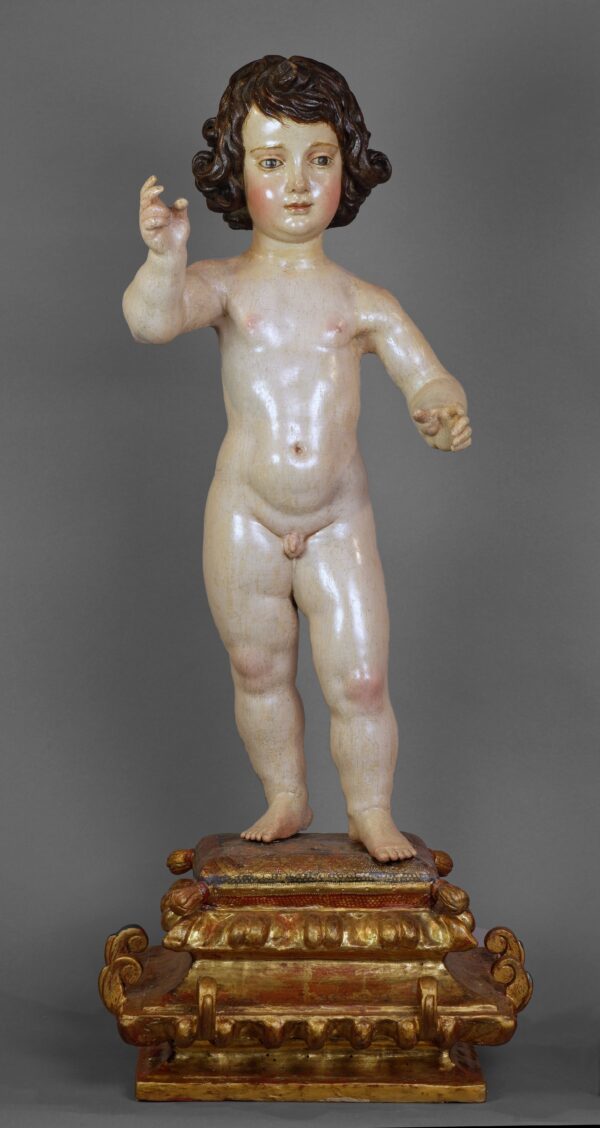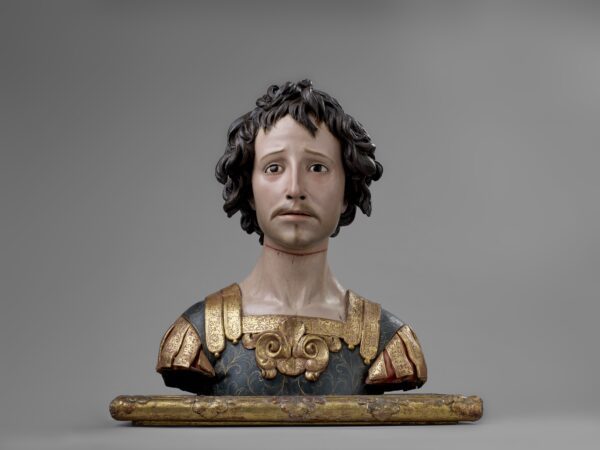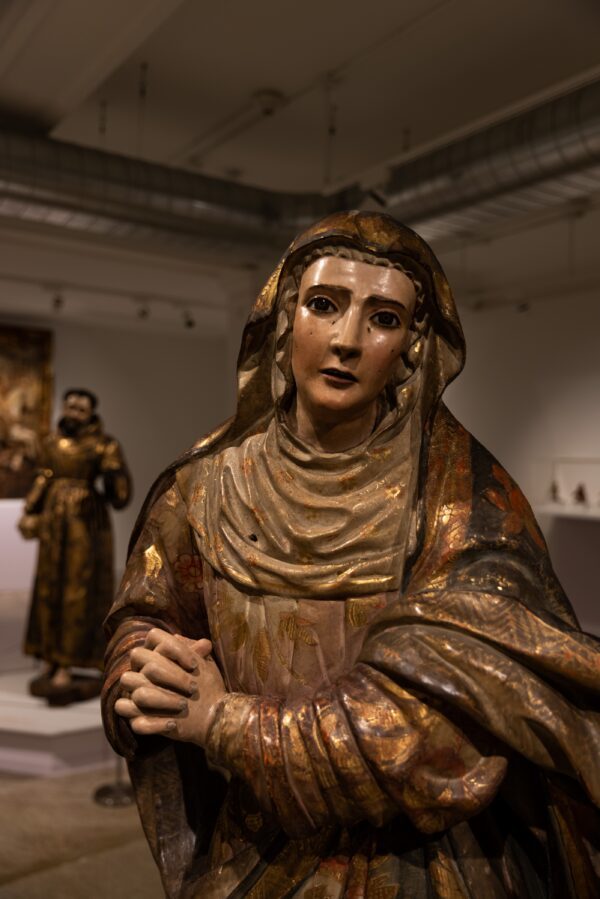“Hispanic Society Museum and Library” Exhibition: “Gilded Figures: Sculptures Made of Wood and Clay”
Text/Lorraine Ferrier (Lorraine Ferrier) Translation/Original Spring
“The Mystical Marriage of St. Catherine” by Louisa Roldan, 1692-1706, colorful terracotta; 14 3/8 inches x 17 3/4 inches x 11 5/8 inches x 32 1/4 inch. (Provided by The Hispanic Society Museum & Library)
Uncolored stone, marble, or bronze sculptures dominate the Western sacred art, thanks in large part to Renaissance masters such as Donatello and Michelangelo, The Baroque sculptor Gian Lorenzo Bernini and the neoclassical sculptor Antonio Canova.
Click onhereCan read the upper part of this article
The suffering of the martyrs
Patrick Lenaghan (Patrick Lenaghan, the main curator of prints, photos, and sculptures at the Spanish Society Museum and Library in New York) said that by carefully observing some of the sculptures in the exhibition, you can see “damages left by use.” In Alonso Martínez’s Blessing Christ Child (Blessing Christ Child), the characters have bruises on their necks and arms. Over the years, the nude statues have been dressed in different costumes, causing wear and tear on the coating where the clothes are worn and pulled down.

The way sculpture owners change their works is often quite fascinating. In the exhibition, a bust of a handsome man by Pedro de Mena is cleverly presented using glass eyes, a neatly trimmed beard and a slightly opened mouth. However, a closer look reveals that the man has a scar on his throat, and his face is full of shock and despair. This bust depicts St. Acisclus, a former Roman soldier who was martyred for his faith in the 4th century.

This bust was originally a more emotional and inspiring image. An old photo shows that the statue originally had a complete forearm and torso. Tears made of glass slid down the man’s face, and there was more blood on his neck. Lenahan said: “Its initial appearance emphasizes how to stick to one’s faith in the face of suffering.” He believes that in order to make the sculpture more popular with buyers, the statue was downplayed and turned into a bust. , Perhaps because the ancient bust is more optimistic.
Another example that has been changed is a work called “The Crucifixion”. This work puzzled Lenahan because he didn’t know who the sculptor was. In the work, Christ is nailed to the cross and the Virgin Mary is at his feet. The Hispanic Society bought it at an auction, and there was no time to find out who it came from.
However, he quickly realized that the Virgin Mary in the work was created by the 19th-century Spanish sculptor Manuel González Santos (Manuel González Santos), but this piece of “The Crucifixion” The work does not reflect the sculptor’s style at all. When a friend strongly suggested that this work was from the 17th century Spanish sculptor Pablo de Rojas (Pablo de Rojas), Lenahan was shocked. He said: “I was stunned, because it was a big surprise to own the statue of Pablo de Rojas.” Leinerhan now believes that the Virgin Mary in the work is about two hundred years later, the owner and the owner of the statue. Up.
Affect the new world
When the Spaniards came to the New World, religious sculptures played an important role in converting local residents to Catholicism. Whenever there is an opportunity, Spanish sculptors will pass on their techniques to local sculptors, so that Latin American religious works also have the same Spanish style. For example, the two works in the exhibition-“St. Francis” (St. Francis) and “Mater Dolorosa” (Mater Dolorosa) have always been considered the works of Spanish masters, and until recently were they recognized as the works of Mexican artists.

Sometimes, Latin American artists merge Spanish styles to make sculptures show a special local style. For example, in Spain, gold is usually used in the bottom layer of sculptures. After applying paint on it, some of the paint on the surface will be scraped off, revealing the gold coating underneath. But there is still part of the gold hidden under the paint to further enhance the effect of the paint. Lenahan explained that artists in Quito, Ecuador used not only gold, but also silver as the base for their statues. This practice already exists in Spain, but Ecuadorian sculptors put it together with gold to give it a stronger effect.


Lenahan explained that Quito is the fourth largest city in the New World, after Lima, Havana and Mexico City. Part of Quito’s wealth comes from its numerous silver mines. “Virgin of Quito” and “St. Michael Archangel” in the exhibition are two examples of Quito craftsmanship. They both use gold and silver as a primer. The silver primer is used in these works to enhance the red and blue colors, giving the works a shiny texture like electric light.
One of the highlights of the exhibition is the work “the Four fate of Man” from Quito, authored by Manuel Chili, and his better known name is Caspi Cara (Caspicara). This is an impressive work that vividly shows the audience the various consequences of an immoral life and a moral life following the divine precepts. Little is known about this work; there is currently no similar form of sculpture.

Lenahan explained that Caspicara may have received general guidance on iconographic and theological concepts from the wax figures in Naples, which show the soul in hell. Lenahan was impressed by the details on this set of figurines, which illustrate the author’s amazing talent and dexterity.
“With the development of the 18th century, neoclassical norms and aesthetics began to prevail in Spain. There were more restrictions on some statues, and perhaps no such straightforward expression of emotion. But the importance of emotion in artistic subjects… Never left the focus, because I think that in the pre-modern world, holiness comes from suffering. Therefore, the measure of holiness is how much suffering you have suffered and your dedication to faith.” Lenahan added at last. ◇
The “Gilded Figures: Sculptures Made of Wood and Clay” at the “Hispanic Society Museum and Library” in New York will last until January 9, 2022. For more information, please click here.
Original: Made for the Devout: The Gloriously Colorful World of Hispanic Sacred Sculptures was published in the English “Epoch Times“.
Editor in charge: Han Yu#
.
